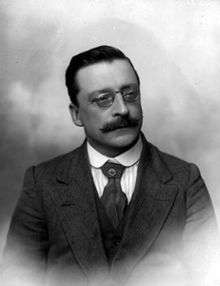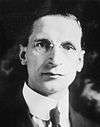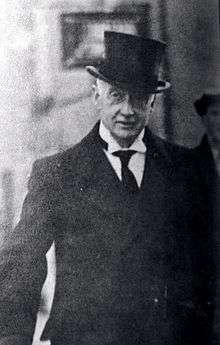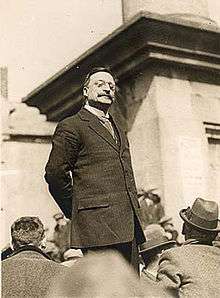Arthur Griffith
| Arthur Griffith | |
|---|---|
 | |
| President of Dáil Éireann | |
|
In office 10 January 1922 – 12 August 1922 | |
| Preceded by | Éamon de Valera |
| Succeeded by | W. T. Cosgrave |
| Constituency | Cavan |
| Minister for Foreign Affairs | |
|
In office 26 August 1921 – 9 January 1922 | |
| Preceded by | Count Plunkett |
| Succeeded by | George Gavan Duffy |
| Personal details | |
| Born |
31 March 1872 Dublin, Ireland |
| Died |
12 August 1922 (aged 50) Dublin, Ireland |
| Nationality | Irish |
| Political party | Sinn Féin |
| Spouse(s) | Maud Sheehan Griffith |
| Children | 2 |
| Religion | Roman Catholicism[1] |
Arthur Griffith (Irish: Art Ó Gríobhtha; 31 March 1872 – 12 August 1922) was an Irish politician and writer, who founded and later led the political party Sinn Féin. He served as President of Dáil Éireann from January to August 1922, and was chairman of the Irish delegation at the negotiations in London that produced the Anglo-Irish Treaty of 1921.
Early life
Arthur Griffith was born at 61 Upper Dominick Street, Dublin, Ireland on 31 March 1872, of distant Welsh lineage, and was educated by the Irish Christian Brothers. He worked for a time as a printer before joining the Gaelic League, which was aimed at promoting the restoration of the Irish language.
His father had been a printer on The Nation newspaper — Griffith was one of several employees locked out in the early 1890s due to a dispute with a new owner of the paper. The young Griffith was a member of the Irish Republican Brotherhood (IRB). He visited South Africa from 1897 to 1898, after the defeat and death of Charles Stewart Parnell whose more moderate views he had initially supported, while recovering from tuberculosis. There he supported the Boers against British expansionism and was a strong admirer of Paul Kruger.
In 1899, on returning to Dublin, he co-founded the weekly United Irishman newspaper with his associate William Rooney, who died in 1901. On 24 November 1910, Griffith married his fiancée, Maud Sheehan, after a fifteen-year engagement; they had a son and a daughter.
Griffith's fierce criticism of the Irish Parliamentary Party's alliance with British Liberalism was heavily influenced by the anti-Liberal rhetoric of Young Irelander John Mitchel. Griffith made a number of highly controversial statements and opinions. He defended anti-semitic rioters in Limerick, and denounced socialists and pacifists as conscious tools of the British Empire. Griffith also supported movements seeking national independence from the British Empire in Egypt and India and wrote a highly critical description of the British government action at Matabele. Despite his opposition to communism and socialism, he sometimes worked with James Connolly, who also supported Irish nationalism.[2]
In September 1900, he established an organisation called Cumann na nGaedheal ("Society of Gaels") to unite advanced nationalist/separatist groups and clubs. In 1903 he set up the National Council to campaign against the visit to Ireland of King Edward VII and his consort Alexandra of Denmark.[3] In 1907, this organisation merged with the Sinn Féin League, which itself had been formed from an amalgamation of Cumann na nGaedheal and the Dungannon Clubs, to form what would become Sinn Féin.[4]
In 1906, after the United Irishman journal collapsed because of a libel suit, Griffith refounded it under the title Sinn Féin; it briefly became a daily in 1909 and survived until its suppression by the British government in 1914, after which he became editor of the new nationalist journal, Nationality.
Foundation of Sinn Féin
| Príomh Aire |
|---|
|
Cathal Brugha |
 Éamon de Valera |
| President of the Republic |
 Éamon de Valera |
|
President of the Dáil Éireann |
.jpg) Arthur Griffith |
 W. T. Cosgrave |
|
Office abolished December 1922 |
Most historians opt for 28 November 1905 as a founding date because it was on this date that Griffith first presented his 'Sinn Féin Policy'. In his writings, Griffith declared that the Act of Union of Great Britain and Ireland in 1800 was illegal and that, consequently, the Anglo-Irish dual monarchy that existed under Grattan's Parliament and the so-called Constitution of 1782 were still in effect. Its first president was Edward Martyn.
The fundamental principles on which Sinn Féin was founded were outlined in an article published in 1904 by Griffith called The Resurrection of Hungary, in which, noting how in 1867 Hungary went from being part of the Austrian Empire to a separate co-equal kingdom in Austria-Hungary. Though not a monarchist himself, Griffith advocated such an approach for the Anglo-Irish relationship, namely that Ireland should become a separate kingdom alongside Great Britain, the two forming a dual monarchy with a shared monarch but separate governments, as it was thought this solution would be more palatable to the British. This was similar to the policy of Henry Grattan a century earlier. However, this idea was never really embraced by later separatist leaders, especially Michael Collins, and never came to anything, although Kevin O'Higgins toyed with the idea as a means of ending partition, shortly before his assassination.
Griffith sought to combine elements of Parnellism with the traditional separatist approach; he saw himself not as a leader but as providing a strategy which a new leader might follow. Central to his strategy was parliamentary abstention: the belief that Irish MPs should refuse to attend the Parliament of the United Kingdom at Westminster, but should instead establish a separate Irish parliament (with an administrative system based on local government) in Dublin.
In 1907 Sinn Féin unsuccessfully contested a by-election in North Leitrim, where the sitting MP, one Charles Dolan of Manorhamilton, County Leitrim, had defected to Sinn Féin. At this time Sinn Féin was being infiltrated by the Irish Republican Brotherhood, who saw it as a vehicle for their aims; it had several local councillors (mostly in Dublin, including W. T. Cosgrave) and contained a dissident wing grouped from 1910 around the monthly periodical called Irish Freedom. The IRB members argued that the aim of dual monarchism should be replaced by republicanism, and that Griffith was excessively inclined to compromise with conservative elements (notably in his pro-employer position during the 1913–1914 Dublin Lockout, when he saw the syndicalism of James Larkin as aimed at crippling Irish industry for Great Britain's benefit).
In 1911, he helped to found the Proportional Representation Society of Ireland, believing that proportional representation would help to prevent animosity between unionists and nationalists in an independent Ireland.[5]
1916 Rising
In 1916 rebels seized and took over a number of key locations in Dublin, in what became known as the Easter Rising. After its defeat, it was widely described both by British politicians and the Irish and British media as the "Sinn Féin rebellion", even though Sinn Féin had very limited involvement. When in 1917, surviving leaders of the rebellion were released from gaol (or escaped) they joined Sinn Féin en masse, using it as a vehicle for the advancement of the republic. The result was a bitter clash between those original members who backed Griffith's concept of an Anglo-Irish dual monarchy and the new members, under Éamon de Valera, who wanted to achieve a republic. Matters almost led to a split at the party's Ard Fheis (conference) in October 1917.
In a compromise, it was decided to seek to establish a republic initially, then allow the people to decide whether they wanted a republic or a monarchy, subject to the condition that no member of Britain's royal house could sit on any prospective Irish throne.[6] Griffith resigned the party leadership and presidency at that Ard Fheis, and was replaced by de Valera. The leaders of the Irish Parliamentary Party (IPP) sought a rapprochement with Griffith over the British threat of conscription, which both parties condemned, but Griffith refused unless the IPP embraced his more radical and subversive ideals, a suggestion which John Dillon, a leader of the IPP rubbished as unrealistic, although it would ultimately mean the defeat and dissolution of the IPP after the election in December 1918.
War of Independence
Griffith was elected a Sinn Féin MP in the East Cavan by-election on 20 June 1918 when he asked William O'Brien to move the writ for his candidacy,[7] and held the seat when Sinn Féin subsequently routed the Irish Parliamentary Party at the 1918 general election.[8] In that election he was also returned for the seat of Tyrone North West.
In May 1918, along with Éamon de Valera, and 72 other Sinn Féiners, he was arrested on the pretext that they had conspired with Germany. He spent the next ten months interned in Gloucester jail, being released on 6 March 1919
Sinn Féin's MPs decided not to take their seats in the British House of Commons but instead set up an Irish parliament, Dáil Éireann; the Irish War of Independence followed almost immediately. The dominant leaders in the new Irish Republic were figures like Éamon de Valera, President of Dáil Éireann (1919–21), President of the Republic (1921–1922), and Michael Collins, Minister for Finance, head of the IRB and the Irish Republican Army's Director of Intelligence.
During de Valera's absence in the United States (1919–21) Griffith served as Acting President and gave regular press interviews. He was arrested at his house at 3am on 26 November 1920[9] and later jailed, spending the next seven months in Dublin's Mountjoy prison but he was subsequently released on 30 June 1921.
In Ireland, a General election was held on 24 May 1921 and Griffith, whilst still in prison, headed the poll in the contested constituency of Fermanagh and Tyrone, while also being returned unopposed for Cavan. On 26 August 1921, Griffith was appointed minister for foreign affairs in the new Irish cabinet.
Treaty negotiations and death
In September 1921, de Valera, President of the Irish Republic, asked Griffith to head the delegation of Irish plenipotentiaries to negotiate with the British government. The delegates set up Headquarters in Hans Place, London. After nearly 2 months of negotiations it was there, in private conversations, that the delegates finally decided to recommend the Treaty to the Dáil Éireann on 5 December 1921; negotiations closed at 2.20am on 6 December 1921. Griffith was the member of the treaty delegation most supportive of its eventual outcome, a compromise based on dominion status, rather than a republic. After the ratification by 64 votes to 57 of the Anglo-Irish Treaty by the Second Dáil on 7 January 1922, he replaced de Valera, who stepped down in protest as President of the soon-to-be abolished Irish Republic. A vote was held on 9 January to choose between Griffith or De Valera, which De Valera lost by 58 to 60. A second ratification of the Treaty by the House of Commons of Southern Ireland followed shortly afterwards. Griffith was, however, to a great extent merely a figurehead as President of the second Dáil Éireann and his relations with Michael Collins, head of the new Provisional Government, were somewhat tense.

Suffering from overwork and strain after the long and difficult negotiations with the British government, Griffith attended forty-one of the forty-two provisional government meetings held between 23 June and 30 July, and the work involved in establishing the Free State government, he entered St. Vincent's Nursing Home, Leeson Street, Dublin, during the first week of August 1922, following an acute attack of tonsillitis.[10] He was confined to a room in St Vincent's by his doctors, who had observed signs of what they thought might be a subarachnoid hemorrhage, but it was difficult to keep him quiet,[11] and he resumed his daily work in the government building. He had been about to leave for his office shortly before 10 am on 12 August 1922, when he paused to retie his shoelace and fell down unconscious. He regained consciousness, but collapsed again with blood coming from his mouth. Three doctors rendered assistance, but to no avail. Father John Lee of the Marist Fathers administered extreme unction, and Griffith expired as the priest recited the concluding prayer. The cause of death was reported as being due to heart failure.[12] He died at the age of 50, ten days before Michael Collins' assassination in County Cork. He was buried in Glasnevin Cemetery four days later.
Posthumous commemoration
The historian Diarmaid Ferriter considers that, though he had founded Sinn Féin, Griffith was 'quickly airbrushed' from Irish history. His widow had to beg his former colleagues for a pension, saying that he 'had made them all'. She considered that his grave plot was too modest and threatened to exhume his body. Only in 1968 was a plaque fixed on his former home.[13]
Griffith Barracks which is now Griffith College Dublin on South Circular Road, Dublin, Griffith Avenue in North Dublin, Griffith Park in Drumcondra and Arthur Griffith Park in Lucan, County Dublin are named after him. An obelisk erected in 1950 in the grounds of Leinster House commemorates Griffith, as well as Michael Collins and Kevin O'Higgins.[14]
Early anti-semitic views
The charge of anti-semitism has often been levelled at Griffith.[15] He published articles signed by 'The Home Secretary' in his newspaper, the United Irishman, during the Dreyfus Affair which displayed clear hatred for Jews. Even after Alfred Dreyfus had been pardoned Griffith remained virulently anti-Dreyfus. In 1899 he wrote in the United Irishman:
I have in former years often declared that the Three Evil Influences of the century were the Pirate, the Freemason, and the Jew.[16]

Following the Dreyfus Affair, an article in the 16 September 1899 edition of the United Irishman stated:
A few days ago a Jew traitor, who had sold the most vital secrets of France to her military enemies, was condemned to the mild punishment of imprisonment, after his guilt had been for a second time in five years demonstrated to a court martial of his comrades ... The simple fact is that the whole European world, with the exception of the Anglo-Jew coalition and its Irish sycophants, is utterly indifferent to the traitor's fate.[16]
Griffith's editorial support for the Limerick Boycott (a boycott of Jewish businesses in Limerick organised by the Redemptorist Father John Creagh in 1904) has also been criticised. His claim that it was a boycott of usurers is weakened by the fact that the vast majority of the people affected by the boycott were tradesmen:
When Catholics – as Catholics – are boycotted, it constitutes undoubtedly an outrageous injustice, and similarly if Jews - as Jews - were boycotted, it would be outrageously unjust. But the Jew in Limerick has not been boycotted because he is a Jew, but because he is a usurer. And we deny that we offend against ethics by most heartily advocating the boycott of usurers, whether they be Jew, Pagan or Christian.[1]
As his biographer Brian Maye has pointed out, Griffith clearly had a "wildly exaggerated notion of the extent of Jewish involvement in money-lending and devious business practices".[17] Maye also noted that while Griffith criticised Catholic associations such as the Knights of Saint Columbanus he was never indicted as anti-Catholic.[18]
According to Maye, from 1904 until his death Griffith wrote virtually nothing which could be construed as anti-semitic.[17] In 1909 in an article on Dublin Municipal elections held that year, Griffith wrote: "The latest element of the population publicly appealed to vote against the Sinn Féin candidates is the Jewish element, to whom an appeal is made in the correspondence columns of the Evening Telegraph. As this is done openly by a Jew, we have nothing to say on the matter, except to regret that the Jews in Dublin should cast their votes as Jews instead of as citizens."[19][20] In September 1912, he wrote that the Gaelic Irish could trace some Hebrew ancestry.[21]
Griffith met Jewish solicitor Michael Noyk in 1909 and the pair would become close friends. Noyk defended many IRA members in courts martial during the Irish War of Independence and served as an official in the First Dáil Department of Finance and as a Dáil Court judge during the war.[22] Friends included Dr Edward Lipman, Jacob Elyan, Philip Sayers and Dr Bethel Solomons, who contributed to the purchase of a house for Griffith when he married.[23]
Quotations
- "In Arthur Griffith there is a mighty force in Ireland. He has none of the wildness of some I could name. Instead there is an abundance of wisdom and an awareness of things which are Ireland." – Michael Collins.
- "A braver man than Arthur Griffith, I never met" – The Earl of Birkenhead, British negotiator in the Treaty, quoted from Tim Pat Coogan's Michael Collins.
See also
- List of people on the postage stamps of Ireland
- List of members of the Oireachtas imprisoned during the Irish revolutionary period
Sources
- Patrick Maume, The Long Gestation (Gill & Macmillan, 1999).
- There is a 2003 reprint of The Resurrection of Hungary with an introduction by Patrick Murray (University College Dublin Press).
- The Treaty Debates on-line (Dec 1921 – Jan 1922)
- Anthony J. Jordan, Arthur Griffith with James Joyce & WB Yeats – "Liberating Ireland" [Westport Books 2013]
References
- 1 2 Maye, Brian: Arthur Griffith, Dublin, Griffith College Publications, 1997, p. 368
- ↑ Review of Brian Maye's Arthur Griffith by Patrick Maume, History Ireland, 6:1 (Spring 1998)
- ↑ Irish Leaving cert history textbook; Movements for Political and Social Reform 1870–1914.
- ↑ Boyce, D. George; O'Day, Alan (2004). Ireland in Transition, 1867-1921. Routledge. p. 155. ISBN 1134320000. Retrieved 18 March 2016.
- ↑ John Coakley and Michael Gallagher, Politics in the Republic of Ireland (Taylor & Francis, 2010), 113.
- ↑ Packenham, Frank (1974). Éamon de Valera. Arrow Books. p. 68. Retrieved 7 April 2016.
- ↑ Maume, Patrick: The long Gestation, Irish Nationalist Life 1891–1918 p. 207 (note 322), Gill & Macmillan (1999); ISBN 0-7171-2744-3
- ↑ "Arthur Griffith". ElectionsIreland.org. Retrieved 1 June 2009.
- ↑ http://hansard.millbanksystems.com/commons/1920/nov/26/mr-arthur-griffith-arrest
- ↑ Glandon, Virginia E. (1985). Arthur Griffith and the Advanced-nationalist Press, Ireland, 1900–1922. P. Lang. p. 230. ISBN 0-8204-0041-6.
- ↑ O'Connor, Ulick (1996). Michael Collins and the Troubles. W.W. Norton. ISBN 0-393-31645-9.
- ↑ "Arthur Griffith Dies Suddenly" (PDF). New York Times. 13 August 1922.
- ↑ Ferriter, D. The Transformation of Ireland 1900–2000 (Profile 2004) p. 260; ISBN 1-86197-307-1
- ↑ The OPW – a history of service (PDF). The Office of Public Works. 2006. p. 5.
- ↑ "Arthur Griffith, anti-Semite", The Spectator, 11 October 1997 (BNET Business Library); retrieved 24 January 2010.
- 1 2 Keogh, Dermot (1998). Jews in Twentieth-century Ireland: Refugees, Anti-semitism and the Holocaust. Cork University Press. p. 22. ISBN 1-85918-150-3.
- 1 2 Maye, op. cit, p. 368.
- ↑ Maye, op. cit, p. 371.
- ↑ Maye, op. cit., p. 369.
- ↑ Sinn Féin, 16 January 1909
- ↑ Sinn Féin, 14 September 1912.
- ↑ Benson, Asher (2007). Jewish Dublin. ISBN 978-1-906353-00-1.
- ↑ Manus O'Riordan, Citizens of the Republic, Jewish History in Ireland, Dublin Review of Books, Summer 2007
External links
| Wikimedia Commons has media related to Arthur Griffith. |
| Parliament of the United Kingdom | ||
|---|---|---|
| Preceded by Samuel Young |
Sinn Féin Member of Parliament for Cavan East 1918–1922 |
Succeeded by Constituency abolished |
| Preceded by New Constituency |
Sinn Féin Member of Parliament for North West Tyrone 1918–1922 |
Succeeded by Constituency abolished |
| Oireachtas | ||
| New constituency | Sinn Féin Teachta Dála for Cavan East 1918–1921 |
Succeeded by Constituency abolished |
| New constituency | Sinn Féin Teachta Dála for Fermanagh and Tyrone 1921–1922 |
Succeeded by Alex Donnelly |
| New constituency | Sinn Féin Teachta Dála for Cavan 1921–1922 |
Succeeded by Patrick Smith |
| Political offices | ||
| Preceded by Michael Collins |
Minister for Home Affairs 1919–1921 |
Succeeded by Frank Aiken |
| Preceded by Count Plunkett |
Minister for Foreign Affairs 1921–1922 |
Succeeded by George Gavan Duffy |
| Preceded by Éamon de Valera |
President of Dáil Éireann 1922 |
Succeeded by W. T. Cosgrave |
| Party political offices | ||
| Preceded by New position |
Vice-President of Sinn Féin 1905–1908 with John Sweetman (1905–1907) with Bulmer Hobson (1907–1908) |
Succeeded by Bulmer Hobson |
| Preceded by John Sweetman |
President of Sinn Féin 1911–1917 |
Succeeded by Éamon de Valera |
| Preceded by ? Thomas Kelly (1910–) |
Vice-President of Sinn Féin 1917–1922 with Michael O'Flanagan |
Succeeded by Michael O'Flanagan |